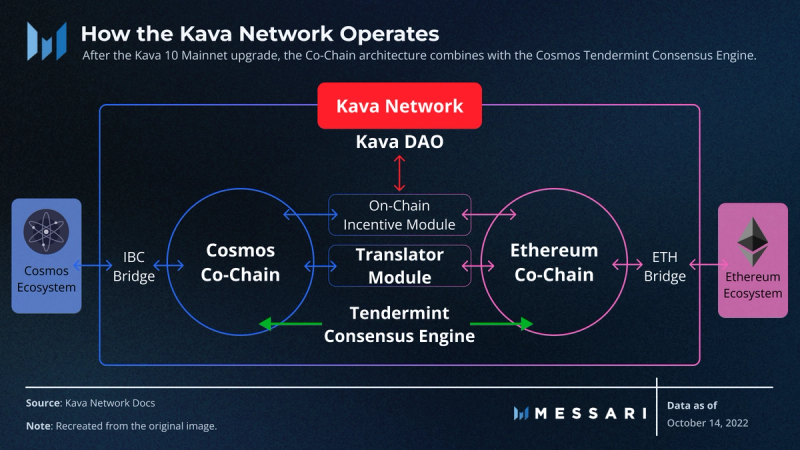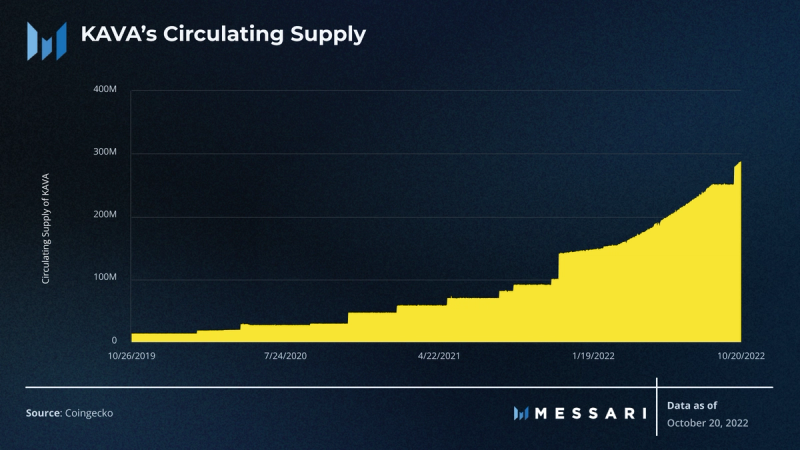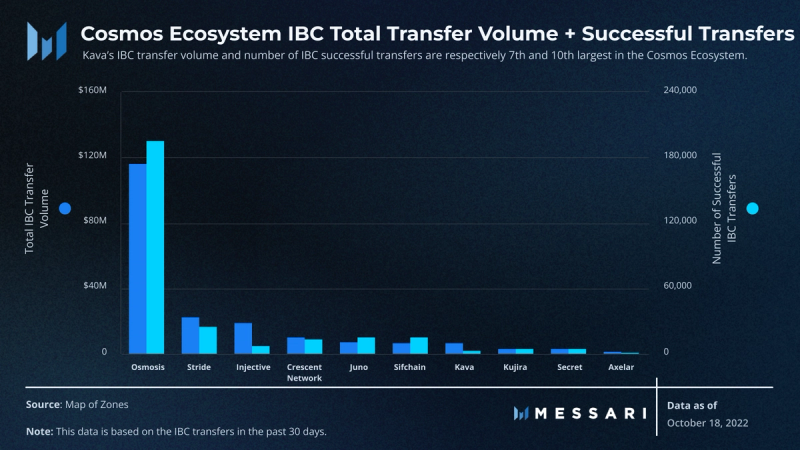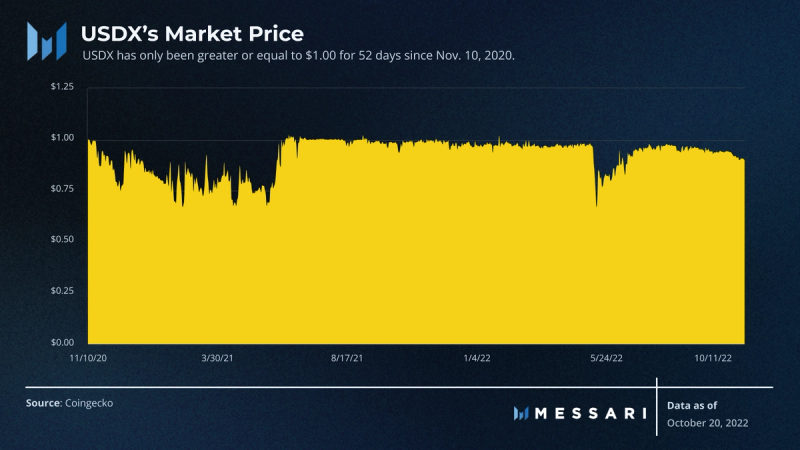Key Insights
- Kava Network’s unique Co-Chain architecture provides the network with the speed and flexibility of Ethereum smart contracts and the interoperability of the Cosmos SDK framework.
- Although the Kava Network’s TVL significantly decreased since its all-time-highs during the bull market, the Kava Network’s current DeFi market share has increased since the beginning of 2022. This shows the growing strength of the Kava Network relative to the rest of DeFi.
- The introduction of the Multichain bridge and other potential bridge integrations in the future will allow easier access to the Kava ecosystem, which is expected to attract more users and liquidity to the Kava ecosystem.
Background
In 2018, Brian Kerr co-founded Kava Labs with Ruaridh O’Donnell and Scott Stuart. They identified an opportunity to build a Collateralized Debt Position (CDP) product, similar to MakerDAO, but as an interoperable cross-chain DeFi blockchain. The goal of the Kava blockchain was to provide a platform to provide basic DeFi services to major market capitalization chains with limited DeFi service offerings, such as Bitcoin, Ripple, and Binance.
In October 2019, the Kava Network raised $3 million worth of BNB in exchange for 6.52 million KAVA via an Initial Exchange Offering (IEO) on Binance Launchpad. Over the past four years, the Kava Network has developed into a Layer-1 blockchain that combines the Ethereum and Cosmos ecosystems with its co-chain architecture. As of Nov. 14, 2022, the Kava Network has a total value locked (TVL) of $216.27 million and ranks 13th in TVL across all chains.
How the Kava Network Operates
Kava’s Co-Chain architecture combines the flexibility and speed of Ethereum’s smart contract development with the interoperability of the Cosmos SDK framework in a single network. This architecture is powered by the Tendermint Consensus Engine, creating an EVM-compatible chain that allows developers to deploy smart contracts for their protocols with Solidity. The Translator Module operates between the Cosmos and Ethereum environments in the Co-Chain architecture, allowing them to communicate and work together seamlessly.

Validators are required to run the Kava Network’s Tendermint Consensus Engine, which is designed to run Proof-of-Stake (PoS) blockchains. However, only the top 100 validators based on weighted stake (self-delegations + other delegations) are eligible for block rewards.
As of the Kava 10 Mainnet upgrade, the On-Chain Incentive Module uses KAVA emissions to incentivize developers to build and grow protocols in the Kava ecosystem. Based on usage metrics and TVL, the top 100 protocols on the Ethereum Co-Chain will receive and share a pro-rata distribution of KAVA emissions. In theory, distributing KAVA emissions to developers encourages developers and protocols to grow the Kava Network’s usage and TVL metrics. However, currently, there are over 40 active protocols in the Kava ecosystem. Thus, all active protocols currently receive KAVA emissions.
Kava uses the Inter-Blockchain Communication (IBC) protocol to communicate and bridge to all other Cosmos-SDK blockchains. IBC allows the Kava network to quickly implement desirable open-source modules that have been developed for the Cosmos ecosystem.
KAVA Tokenomics
The native governance and utility token of the Kava Network is KAVA. It is used for governance voting, the validator staking and delegation mechanism, inflationary rewards for various network activities (i.e., Kava Earn and Pools), mint USDX on Kava Mint, borrowing and lending activities on Kava Lend, and to pay for transaction fees on the Kava Network. KAVA’s total token supply is uncapped.

USDX
Kava Network’s native decentralized stablecoin is USDX. Crypto assets from chains lacking basic DeFi services can be deposited into Kava Mint, a collateralized debt position (CDP) protocol, and exchanged for USDX. Similar to how DAI is MakerDAO’s decentralized stablecoin on Ethereum. USDX’s current circulating supply is approximately 88 million.
Kava Rise
To attract higher-quality builders, Kava has launched the Kava Rise program alongside the Kava 10 upgrade. Over four years, Kava will distribute 200 million KAVA on-chain. Notably, 63.5% of the KAVA block rewards from each block will be distributed to the Developers (the top 100 Kava protocols) and 37.5% will go to Stakers, as long as the protocols meet the eligibility requirements. The KAVA token distributions from this program will be based on monthly usage, “calculated by the time-weighted TVL of the protocol as a share of the collective TVL of the top 100 protocols.”
The Kava Rise program has begun to bring quantifiable value to the Kava Network. Two notable protocols that the Kava Rise program has attracted are Curve, Sushi, and Beefy Finance. Curve has added $20.26 million to Kava Network’s TVL, Sushi has added $1.05 million to Kava Network’s TVL, and Beefy Finance has added approximately $897,000. Within the last two months, each protocol launched on the Kava Network and already accounts for about 9% of Kava Network’s TVL.
Governance
The Kava DAO governs the Kava network. The DAO voters consist of Kava stakers and validators that secure and run the network, but anyone can create a proposal as long as the proposer deposits 1,000 KAVA for the proposal to go into effect. The primary goal of Kava’s governance is to determine how on-chain developer incentives are distributed between the two Co-Chains, but Kava’s governance is unbound and proposals can be regarding any aspect of the Kava Network.
ATOMScan and Mintscan are the EtherScans for the Cosmos ecosystem and service the Kava Network. ATOMScan and Mintscan provide community members the ability to view how Kava DAO members have voted on current and past on-chain governance votes. Additionally, ATOMScan has a dashboard showing the top 100 Kava validators with the following data: current commission rate, maximum commission rate, validator active/inactive status, Kava delegations, and percentage of the total voting power.
Kava Foundation
The Kava Foundation is responsible for the security and growth of the Kava Network by aiding in the deployment of $200 million in assets from the Kava Community Pool. This pool is governed by the Kava DAO and aims to safeguard the growth of the following three layers:
- Proof-of-Stake (PoS) Security
- Infrastructure Security
- Financial Reserve Security
The Financial Reserve Security layer is the source of capital for the Kava Rise Program.
Kava Protocols
Kava Labs is responsible for building and maintaining Kava Mint, Kava Lend, Kava Swap, and Kava Earn. Currently, Kava Mint, Lend, and Swap are three of the four largest protocols in terms of TVL on the Kava Network.
Kava Mint is a CDP protocol that allows users to deposit their tokens as collateral and receive Kava’s native decentralized stablecoin, USDX, in return as a loan with interest fees between 0-5%. Users can utilize their newly minted USDX within the Kava DeFi ecosystem to potentially earn rewards. Kava Mint’s TVL is approximately $125.66 million.
Kava Lend is a borrowing and lending market protocol that allows users to supply or borrow any token accepted by the protocol. Supplying or borrowing tokens allows users to earn supply APY and reward APY. Kava Lend’s TVL is approximately $108.56 million.
Kava Swap is a decentralized exchange (DEX) protocol that allows users to swap any token accepted by the protocol. Providing liquidity through the Pools product of Kava Swap allows users to earn pool APY and rewards APY. Kava Swap’s TVL is approximately $7.3 million.
Kava Earn is a Kava-native protocol that aims to simplify complex DeFi strategies by allowing users a straightforward supply-and-withdraw user experience, similar to Yearn Vaults. The only assets Kava Earn accepts are KAVA, bKAVA, BUSD, and USDC. Kava Earn provides an APY incentive for bKAVA tokenholders to lock their bKAVA, which in turn is expected to increase Kava’s daily active users and TVL. Kava Earn’s TVL is approximately $80.7 million.
Traction
The total IBC transfer volume and successful IBC transfers metrics provide insight into the activity level of app-chains and chains in the Cosmos ecosystem. Even though Osmosis dominates these two metrics, based on the 41 app chains and chains that have integrated with the IBC Protocol, Kava ranks seventh in total IBC transfer volume and tenth in successful IBC transfers over the past 30 days.

The Kava Network’s TVL has decreased 62.2% in USD terms from its all-time-high of $703.4 million in November 2021. Kava’s TVL was barely affected by the Terra LUNA crash, as only
$5.7 million of Kava’s TVL consisted of UST (now USTC). Although UST was an accepted asset by Kava Protocols, the minimal amount of UST in Kava’s TVL appears to have been good risk management by Kava in hindsight. This is especially considering that Terra LUNA is a part of the Cosmos IBC ecosystem and was a logical partner for the Kava Network.

Source: Kava’s Google Data Studio
Despite the Kava Network’s TVL significant decrease since its all-time-highs, the Kava Network’s current DeFi market share has increased since the beginning of 2022, from 0.25% to 0.36%. As Kava continues to execute their roadmap by launching bridges for more chains and introducing bKAVA, the greater likelihood of Kava’s TVL and DeFi market share continues to grow.

Source: Kava’s Google Data Studio
Roadmap
Kava 11 Mainnet
Launched on Oct. 26, 2022, the Kava 11 Mainnet, was a major milestone on Kava’s Roadmap. Kava 11 Mainnet’s major upgrade is Liquid (bKAVA), a fully-convertible liquid staking derivative token that does not have a minimum lock-up period. Liquid allows tokenholders to retain 100% of KAVA token value in the form of bKAVA. This allows KAVA tokenholders to stake their KAVA and receive staking rewards, They can simultaneously receive bKAVA able to be used within Kava’s DeFi ecosystem. Ultimately, the Liquid upgrade allows Kava tokenholders the potential to earn greater rewards than just staking rewards, while encouraging greater activity in Kava’s DeFi ecosystem. Coinciding with the Kava 11 Mainnet launch, Kava Earn will accept bKAVA.
Future Milestones
Kava Network’s roadmap outlines the following key milestones:
- BNB Chain bridge launch will use the Ethereum Co-Chain EVM architecture to unlock over 300 BNB Chain assets that will be compatible with the Kava Network.
- BTC Chain bridge launch will be implemented via the Cosmos Co-Chain to allow BTC, the largest market cap crypto asset, to be compatible with the Kava Network.
- GameFi and NFT Incentive Program will be similar to the Kava Rise program. However, this program aims to provide incentives to the top 100 GameFi and NFT projects building on the Kava Network based on monthly active users and transaction volume.
- Support for CosmWasm. This will allow CosmWasm protocols to be deployed on the Kava Network and give the Kava Network access to the largest developer community outside of the Ethereum and Solana developer communities.
Competitive Landscape
Kava competes directly with Layer-1 blockchains, such as Solana, Avalanche, Near, and Fantom. In general, L1 blockchains are all currently attempting to attract as much liquidity and developer talent as possible. The appeal can be seen through staking rewards, liquidity-providing incentives, developer incentive programs, and grant programs, such as:
- Fantom partnered with Gitcoin Grants to launch a 335 million FTM incentive program.
- The Avalanche Foundation launched a $290 million incentive program.
- NEAR created a grants DAO to distribute a $350 million DeFi incentive program.
The L1 blockchain competition is fiercely trying to attract new users and developers. The introduction of other L1 blockchains launching large incentive programs explains why $750 million in KAVA was allocated to the Kava Rise program.
Notably, the Kava Network does have indirect competition from other CDP lending and borrowing protocols, which are primarily built on Ethereum, such as MakerDAO, Aave, Abracadabra, and Angle Protocol. Each of these protocols, with the exception of Aave, have its own version of a decentralized stablecoin, and Aave is launching its decentralized stablecoin, GHO, soon. There are many borrowing and lending market protocols across various chains, all with the goal of attracting as much liquidity as possible. Not only is greater liquidity positive for growth metrics, but it also provides greater security to users.
Challenges
Two challenges lie ahead for Kava: depegged USDX to USD and bridge security.
At the time of writing, USDX is trading at $0.885 to the USD. USDX is an overcollateralized decentralized stablecoin that has digital assets backing it, in theory, and the collateral backing USDX could be liquidated to pay back USDX tokenholders. However, the further the market price of USDX slips from the USD, the less attractive USDX and the Kava Network look to potential Kava Network investors. Since Nov. 10, 2020, USDX’s market price has been greater or equal to $1.00 for only 52 days.
In the near future, Kava Labs intends to begin accepting additional stablecoins, such as USDC, USDT, and DAI, as collateral for USDX via Kava Mint. This will lower the volatility of the collateral backing USDX, which will also decrease the systemic risks around USDX (i.e., it will be much easier to keep the protocol solvent with non-volatile stable backing USDX). Thus, these additional stablecoins as collateral should increase the confidence of USDX. However, the market will dictate whether USDX will be restored back to the USD peg.

Bridge security has proven difficult for developers to get right. Numerous bridge hacks have occurred over the past year, with over $2 billion having been stolen from bridge hacks. Thus, the more native bridges that Kava builds, the more bridge surface area hackers can attack and exploit the Kava Network. However, additional bridge integrations to the Kava ecosystem are expected to increase users and liquidity, (i.e., when Multichain integrated with the Kava Network).
Conclusion
Building a cross-chain DeFi services network to provide chains that have limited DeFi services is an ambitious goal. However, as stated in their roadmap, this strategic positioning allows Kava a clear path forward. Focusing on building bridges to chains that underserve their tokenholders with basic DeFi services will allow the Kava Network to tap into more digital assets and attract greater liquidity. Despite the potential challenges that the Kava Network faces, the Kava Network has seen steady growth in its DeFi market share percentage, which can be attributed to the success of the Kava Rise program attracting Curve, Sushi, and Beefy Finance.
Let us know what you loved about the report, what may be missing, or share any other feedback by filling out this short form. All responses are subject to our Privacy Policy and Terms of Service.
Looking to dive deeper? Subscribe to Messari Pro. Messari Pro memberships provide access to daily crypto news and insights, exclusive long-form daily research, advanced screener, charting & watchlist features, and access to curated sets of charts and metrics. Learn more at messari.io/pro.
This report was commissioned by Rocket Pool, a member of Protocol Services. All content was produced independently by the author(s) and any opinion, estimate, or probability does not necessarily reflect the opinions of Messari, Inc. or the organization that requested the report. Paid membership in Protocol Services does not influence editorial decisions or content. Crypto projects may commission independent research through Protocol Services. For more details or to join the program, contact ps@messari.io. Author(s) may hold cryptocurrencies named in this report, and each author is subject to Messari’s Code of Conduct and Insider Trading Policy. Additionally, employees are required to disclose their holdings, which are updated monthly and published here. This report is meant for informational purposes only and should not be relied upon. This report is neither financial nor investment advice. You should conduct your own research, and consult an independent financial, tax, or legal advisor before making any investment decisions. Nothing contained in this report is a recommendation or suggestion, directly or indirectly, to buy, sell, make, or hold any investment, loan, commodity, or security, or to undertake any investment or trading strategy with respect to any investment, loan, commodity, security, or any issuer. This report should not be construed as an offer to sell or the solicitation of an offer to buy any security or commodity. Messari does not guarantee the sequence, accuracy, completeness, or timeliness of any information provided in this report. Please see our Terms of Service for more information.












